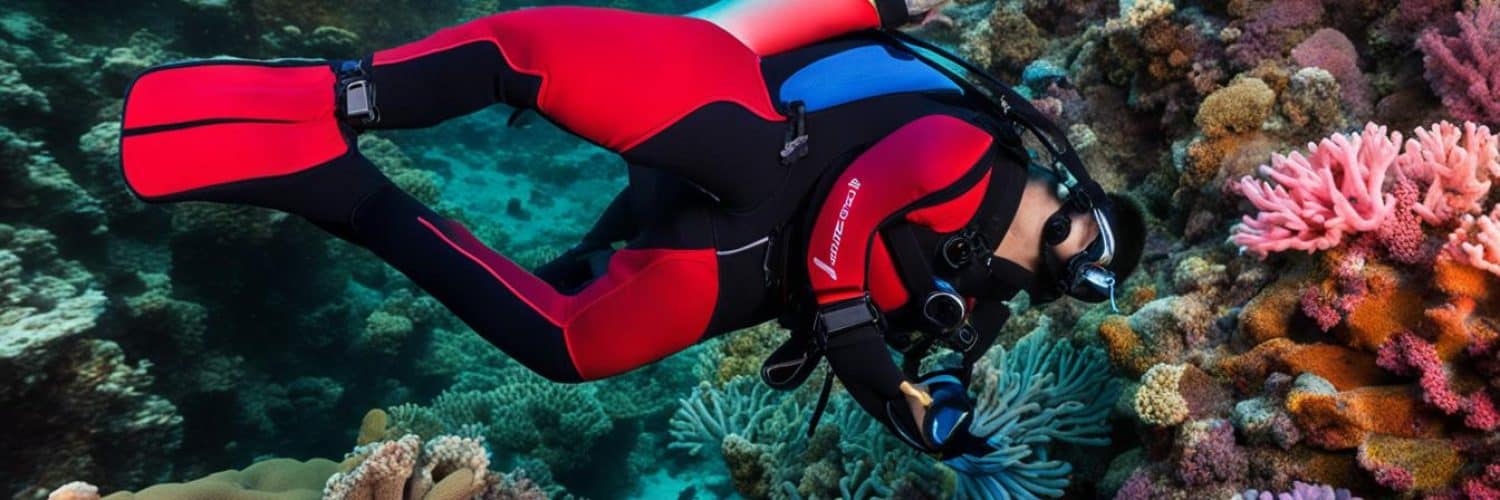When it comes to scuba diving and underwater activities, having the right gear is essential for ensuring a safe and enjoyable experience. One crucial piece of equipment is a reliable pair of diving gloves. These gloves not only protect your hands from cuts, scrapes, and stings in the marine environment but also provide much-needed warmth in colder waters.
There are various types of diving gloves available on the market, each designed to cater to specific diving conditions. From warm-water and tropical gloves to cold water gloves and mittens, there is a wide range to choose from. Additionally, there are options like fingerless gloves, underwater gloves, and gloves specifically designed for scuba diving.
The materials used in diving gloves also play a significant role in their performance. Neoprene gloves are popular and come in different thicknesses, suitable for different water temperatures. Other materials like Kevlar, titanium, synthetic fleece, latex, and nitrile are often incorporated to enhance durability, warmth, grip, and resistance to abrasion.
Key Takeaways:
- Scuba diving gloves provide protection and warmth for your hands while diving.
- There are various types of diving gloves available for different diving conditions.
- The materials used in diving gloves contribute to their durability and performance.
- Choosing the right diving gloves is crucial for ensuring comfort and safety underwater.
- Consider factors like thermal protection, dexterity, fit, and durability when selecting diving gloves.
The Advantages and Limitations of Diving Gloves
Diving gloves provide a range of benefits that enhance the scuba diving experience. One of the key advantages is the protection they offer against cuts, scrapes, and stings from marine life. These gloves act as a barrier, safeguarding your hands from any potential harm while exploring the underwater environment. Furthermore, diving gloves provide thermal insulation, keeping your hands warm in cold-water conditions, which is crucial for prolonged dives in lower temperatures.
However, it’s important to recognize that diving gloves do have some drawbacks. One significant limitation is the potential reduction in dexterity they can cause. Wearing gloves can make certain tasks more challenging, requiring extra effort and cautious movements. This reduction in dexterity can be particularly noticeable when manipulating finer equipment or performing intricate tasks underwater.
“Divers should avoid touching the marine environment, as gloves should not encourage direct contact.”
It is essential for divers to avoid direct contact with the marine environment while wearing gloves. Although gloves provide protection, they should not be used as an excuse to touch or disturb the delicate ecosystem underwater. Respecting the marine environment is paramount, as it ensures the preservation and sustainability of the underwater world for future generations.
| Advantages of Diving Gloves | Limitations of Diving Gloves |
|---|---|
| Protection against cuts, scrapes, and stings from marine life | Reduction in dexterity, making certain tasks more challenging |
| Thermal insulation to keep hands warm in cold-water diving |
Types of Diving Gloves
Diving gloves come in various types, each designed to cater to specific diving conditions and requirements. Whether you’re exploring warm waters or venturing into colder environments, there’s a glove option that suits your needs.
Warm-water gloves: These gloves are specifically designed for diving in warm-water conditions, offering excellent dexterity while ensuring protection against cuts, scrapes, and abrasions. They are ideal for tropical dive destinations where maintaining a good grip and maneuverability are important.
Tropical gloves: Similar to warm-water gloves, tropical gloves prioritize dexterity and protection against potential hazards in tropical diving environments. They offer excellent grip and flexibility, enhancing your diving experience in warm waters.
Cold water gloves: For diving in colder waters, cold water gloves provide superior insulation to keep your hands warm. Made from thicker materials, such as neoprene, they offer maximum warmth and protection in lower temperatures.
Mittens: Mittens are an alternative to standard gloves and provide an extra layer of insulation. They keep your fingers together, reducing heat loss and improving overall warmth. Mittens are particularly useful for extreme cold-water diving.
Three-finger gloves: These gloves combine the benefits of both gloves and mittens. They feature a design where the thumb and first finger are separate, providing increased dexterity and enabling better control while maintaining warmth.
Dry gloves: Dry gloves are used with drysuits to ensure complete hand protection by keeping them dry throughout the dive. These gloves incorporate a sealing mechanism that prevents water from entering the gloves.
Webbed paddle gloves: Webbed paddle gloves are primarily used by disabled divers seeking increased mobility in the water. The webbing between the fingers helps create additional resistance, allowing more efficient movements during diving activities.
Types of Diving Gloves Comparison
| Glove Type | Main Features | Diving Conditions |
|---|---|---|
| Warm-water gloves | High dexterity, protection against cuts and scrapes | Warm-water diving, tropical environments |
| Tropical gloves | Flexible, good grip | Tropical diving locations |
| Cold water gloves | Superior insulation, thicker materials | Cold-water diving |
| Mittens | Extra insulation, fingers kept together | Extreme cold-water diving |
| Three-finger gloves | Combination of dexterity and warmth | Cold-water diving |
| Dry gloves | Complete hand protection, keeps hands dry | Drysuit diving |
| Webbed paddle gloves | Enhanced mobility for disabled divers | All diving conditions |
Materials Used in Diving Gloves
Diving gloves are essential for protecting your hands while diving, and they are made from a variety of materials to suit different diving conditions and preferences. Here are some of the commonly used materials in dive gloves:
Fabric Gloves
Fabric gloves are thin and lightweight, offering excellent dexterity and flexibility. They are ideal for warm-water diving or situations where maximum tactile sensitivity is required. Fabric gloves provide a snug fit and allow for precise hand movements, making them a popular choice among divers.
Neoprene Gloves
Neoprene gloves are made from a synthetic rubber material that provides excellent insulation against cold water. They come in different thicknesses, allowing divers to choose gloves that match the water temperature and their specific needs. Thicker neoprene gloves are suitable for colder waters, while thinner ones are ideal for warmer conditions.
Additional Materials
Some diving gloves are crafted with additional materials to enhance their performance and functionality:
- Kevlar: Gloves reinforced with kevlar offer extra protection from cuts and abrasions, making them ideal for divers in rugged environments.
- Titanium: Titanium-infused gloves provide improved warmth and insulation, ensuring that your hands stay comfortable in colder waters.
- Synthetic Fleece: Gloves with synthetic fleece linings offer added insulation when dry, keeping your hands warm during surface intervals or in between dives.
- Latex and Nitrile: Gloves made with latex or nitrile materials offer enhanced grip and resistance to abrasion, providing excellent control and durability in wet conditions.
By utilizing a combination of these materials, diving gloves are designed to meet the diverse needs and preferences of divers, enhancing their overall diving experience and safety.
The following table highlights the features and benefits of different materials used in diving gloves:
| Material | Features | Benefits |
|---|---|---|
| Fabric Gloves | Thin and lightweight | Excellent dexterity and flexibility |
| Neoprene Gloves | Varying thicknesses | Effective insulation for different water temperatures |
| Kevlar | Reinforced with kevlar | Extra protection against cuts and abrasions |
| Titanium | Infused with titanium | Improved warmth and insulation |
| Synthetic Fleece | With fleece linings | Additional insulation when dry |
| Latex and Nitrile | Made with latex or nitrile | Enhanced grip and resistance to abrasion |
As you can see, different materials offer unique benefits that cater to various diving conditions and personal preferences. Choosing the right material for your diving gloves will ensure optimal comfort, protection, and performance while exploring the underwater world.
Selecting the Right Diving Gloves
The selection of diving gloves depends on several critical factors. When choosing the right diving gloves, it is essential to consider thermal protection, glove thickness, dive glove design, fastenings, linings, sealed seams, and wrist seals.
Thermal protection is paramount when selecting diving gloves. The thickness of the gloves should match the water temperature to ensure optimal warmth during dives. For warm-water diving, lightweight gloves are suitable, offering both protection and flexibility. On the other hand, colder waters necessitate thicker neoprene gloves or even dry gloves for superior insulation.
The dive glove design is also a crucial aspect to consider. Different dives call for different glove designs, such as fingerless gloves for enhanced dexterity or mittens for added warmth. Additionally, fastenings like Velcro or zipper closures enable a secure and comfortable fit.
To enhance comfort and insulation, supplemental linings can be incorporated into diving gloves. These linings help retain heat and further protect the hands from the cold water. The diving gloves may also feature sealed seams to prevent water from seeping in and compromising warmth.
Wrist seals are another consideration when selecting diving gloves. A well-fitted wrist seal ensures a snug and watertight fit, preventing water from entering the gloves and reducing heat loss.
Remember to prioritize the thermal protection, glove design, quality of fastenings, supplemental linings, sealed seams, and wrist seals to select the right diving gloves for your needs.
Importance of Dexterity in Diving Gloves
Diving gloves play a vital role in ensuring the safety and comfort of divers underwater. One key aspect that cannot be overlooked is the importance of dexterity in diving gloves. Manual dexterity refers to the ability to manipulate objects and perform precise movements with the hands. In the context of diving, manual dexterity is essential for various tasks such as gear manipulation, operating lights, and executing hand signals to communicate with other divers.
When wearing diving gloves, divers rely on tactile feedback to interact with their surroundings. The gloves act as a barrier between the hands and the underwater environment, making it crucial to have gloves that allow for a good sense of touch. This tactile feedback enables divers to feel the texture of objects, assess temperature differences, and detect subtle vibrations.
Specialized diving activities like cave diving, wreck diving, and technical diving require a high level of manual dexterity and tactile feedback. In these challenging environments, divers rely heavily on their gloves to navigate through narrow passages, handle intricate equipment, and explore delicate surfaces without causing damage. The ability to feel and interpret the surroundings through gloves is crucial for a successful and safe dive.
To highlight the importance of dexterity in diving gloves, consider the following scenario:
“Imagine a cave diver exploring a narrow underwater cave system. The diver needs to carefully maneuver through tight spaces, relying on hand placement and finger movements for stability. Without proper manual dexterity, the diver could face difficulties in effectively gripping the walls or manipulating their gear. A lack of tactile feedback could also hinder the diver’s ability to assess potential hazards or identify delicate formations.”
Thus, having gloves that provide optimal manual dexterity and tactile feedback is essential for divers to perform critical tasks, ensure safety, and enhance their overall diving experience.
Dive Glove Fit and Comfort
When it comes to diving gloves, finding the right fit is crucial for both comfort and thermal insulation. Gloves that are too tight can restrict movement and put stress on seams, leading to water transfer and chilly hands. On the other hand, gloves that are too loose can allow water to flow freely, compromising warmth. To ensure an optimal glove fit, it should be snug without causing discomfort or hindering freedom of movement.
Properly fitting diving gloves offer several benefits. Firstly, they provide a secure seal that minimizes water transfer, keeping your hands dry and warm throughout your dive. Moreover, a glove with a snug fit allows for better dexterity, enabling precise handling of diving equipment, manipulation of gear, and effective communication through hand signals. When your gloves fit just right, you can focus on enjoying your dive without worrying about cold hands or compromised mobility.
To determine the correct glove fit, it’s important to measure your hand circumference and refer to size charts provided by manufacturers. Remember that glove sizing can vary between brands, so it’s essential to consult the specific measurements for the gloves you’re interested in. Depending on personal preference and the thickness of the gloves, some divers may prefer a slightly looser fit for added comfort, while others may prefer a tighter fit for improved dexterity.
When trying on diving gloves, pay attention to how they feel on your hands. They should fit snugly without causing any discomfort or restricting movement. Make sure to flex and spread your fingers to ensure that you have enough freedom of movement. Additionally, consider the glove design and construction, as certain styles may fit differently due to variations in seam placement and materials used. Lastly, always refer to the manufacturer’s recommendations and guides when selecting the right size for diving gloves.
Key Points:
- Proper glove fit is crucial for comfort and thermal insulation.
- Gloves should fit snugly without restricting movement.
- Gloves that are too small can put stress on seams and allow water transfer, resulting in cold hands.
- Gloves that are too big can allow water to flow freely, reducing warmth.
- The right fit ensures optimum thermal protection and allows for freedom of movement while diving.
Durability and Care of Diving Gloves
Diving gloves are essential gear for protecting your hands while diving, and taking proper care of them will help ensure their longevity and optimal performance. Here are some tips on how to maintain the durability of your diving gloves:
Palm and Finger Reinforcement
Many diving gloves are reinforced with materials such as Kevlar to provide added durability and grip. These reinforcements help protect your hands from cuts, scrapes, and abrasions while diving, ensuring that your gloves can withstand the rigors of underwater exploration.
Seam Construction
The seam construction of diving gloves is another important factor in their durability. Look for gloves with well-sealed seams, as this enhances insulation and reduces water leakage. Strong and well-constructed seams can prevent water from seeping into the gloves, helping to keep your hands warm and dry during your dives.
Caring for Diving Gloves
To prolong the life of your diving gloves, it is crucial to take proper care of them. Here are some care recommendations:
- Rinse your gloves thoroughly with warm water after each dive. This helps remove salt, sand, and other debris that can damage the material over time.
- Use a mild wetsuit wash or gentle detergent to clean your gloves. Make sure to follow the manufacturer’s instructions on cleaning products.
- Allow your gloves to air dry in a shaded area. Direct sunlight can degrade the material and shorten the lifespan of your gloves.
By following these care practices, you can help ensure that your diving gloves remain durable and in good condition, providing reliable protection and comfort during your underwater adventures.
Conclusion
Choosing the best diving gloves is essential for divers to meet their specific needs and ensure comfortable and safe dives. Factors such as water temperature, desired dexterity, and thermal protection play a significant role in determining the right gloves for each individual.
By considering these elements, divers can find the perfect balance of warmth and functionality, ensuring a comfortable diving experience. The best diving gloves offer optimal thermal insulation, allowing divers to enjoy their underwater adventures without worrying about cold hands.
Additionally, the gloves should provide adequate dexterity, enabling divers to manipulate gear, give hand signals, and perform delicate tasks with ease. A snug fit that doesn’t restrict movement contributes to both comfort and safety underwater, allowing for full control and freedom of movement.
Furthermore, durability is crucial in diving gloves to withstand the harsh marine environment. Reinforcements, such as palm and finger reinforcements and sealed seams, enhance the gloves’ durability while protecting against wear and tear.
In conclusion, finding the best diving gloves requires considering a combination of factors, including thermal protection, dexterity, fit, and durability. By choosing the right gloves, divers can ensure comfortable and safe dives, while also protecting their hands from the elements of the underwater world.
FAQ
Why are diving gloves important?
Diving gloves are important for protecting your hands and providing warmth while diving. They also offer additional advantages such as protection against cuts, scrapes, and stings from marine life.
What types of diving gloves are available?
There are different types of diving gloves available, including warm-water and tropical gloves, cold water gloves and mittens, three-finger diving gloves, dry gloves, and webbed paddle gloves.
What materials are used for diving gloves?
Diving gloves are crafted from various materials such as fabric and neoprene. Some gloves may also feature additional materials like Kevlar, titanium, synthetic fleece, latex, and nitrile.
How do I choose the right diving gloves?
The selection of diving gloves depends on factors such as water temperature, desired dexterity, and glove design. It’s important to consider thermal protection, glove thickness, and other features that suit your diving needs.
Why is dexterity important in diving gloves?
Dexterity is crucial for hand movements and gear manipulation while diving. It allows divers to communicate through hand signals, adjust equipment, and handle diving gear with precision.
How should diving gloves fit?
Diving gloves should fit snugly without restricting movement. Gloves that are too small can cause stress on seams, while gloves that are too large may allow water to flow freely, reducing warmth.
How do I care for my diving gloves?
Proper care for diving gloves involves rinsing them with warm water and wetsuit wash after each dive. They should be air-dried in a shaded area, avoiding direct sunlight which can degrade the material over time.
What are the advantages and limitations of diving gloves?
Diving gloves offer advantages such as protection and thermal insulation, but they can reduce dexterity. It’s important to avoid touching the marine environment as gloves should not encourage direct contact.







Add comment